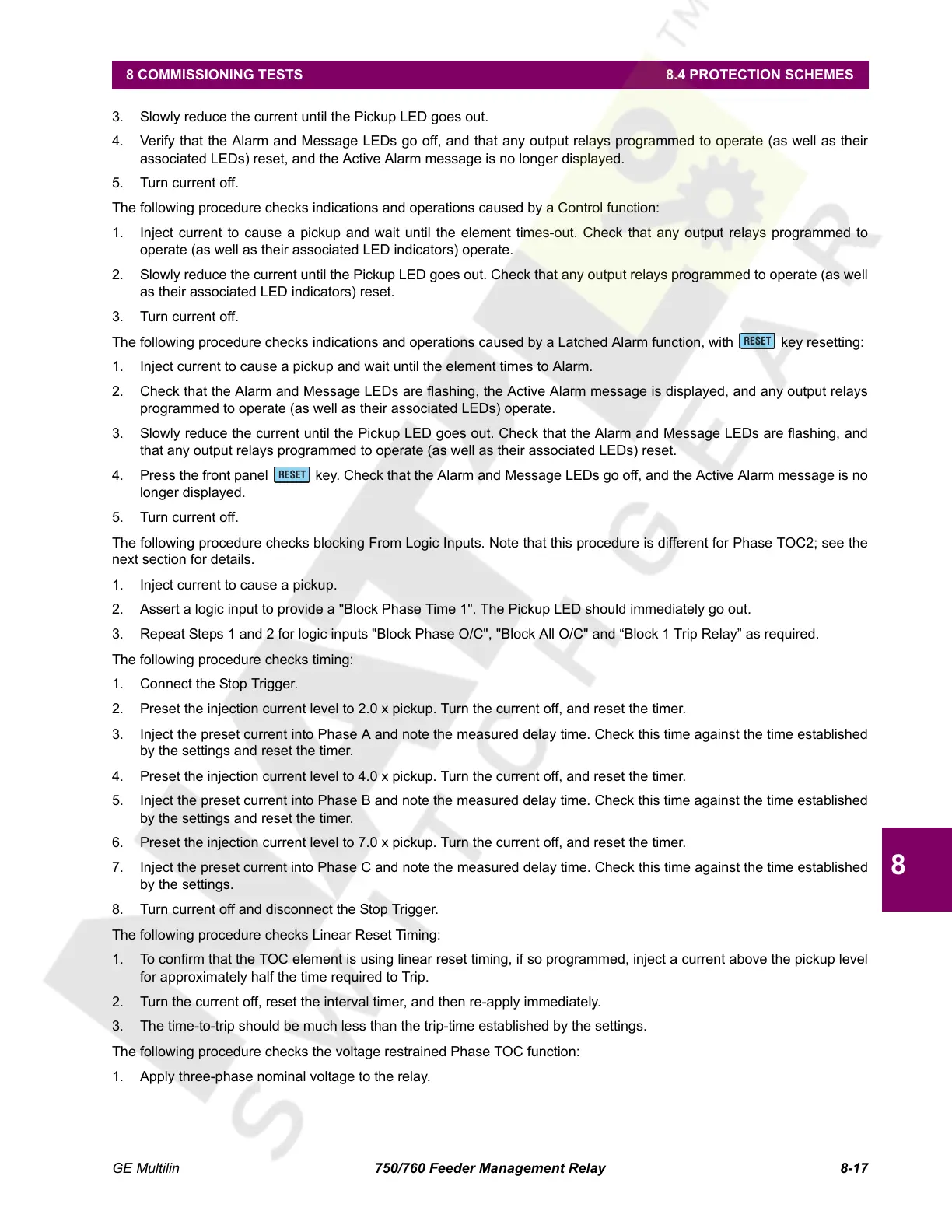GE Multilin 750/760 Feeder Management Relay 8-17
8 COMMISSIONING TESTS 8.4 PROTECTION SCHEMES
8
3. Slowly reduce the current until the Pickup LED goes out.
4. Verify that the Alarm and Message LEDs go off, and that any output relays programmed to operate (as well as their
associated LEDs) reset, and the Active Alarm message is no longer displayed.
5. Turn current off.
The following procedure checks indications and operations caused by a Control function:
1. Inject current to cause a pickup and wait until the element times-out. Check that any output relays programmed to
operate (as well as their associated LED indicators) operate.
2. Slowly reduce the current until the Pickup LED goes out. Check that any output relays programmed to operate (as well
as their associated LED indicators) reset.
3. Turn current off.
The following procedure checks indications and operations caused by a Latched Alarm function, with key resetting:
1. Inject current to cause a pickup and wait until the element times to Alarm.
2. Check that the Alarm and Message LEDs are flashing, the Active Alarm message is displayed, and any output relays
programmed to operate (as well as their associated LEDs) operate.
3. Slowly reduce the current until the Pickup LED goes out. Check that the Alarm and Message LEDs are flashing, and
that any output relays programmed to operate (as well as their associated LEDs) reset.
4. Press the front panel key. Check that the Alarm and Message LEDs go off, and the Active Alarm message is no
longer displayed.
5. Turn current off.
The following procedure checks blocking From Logic Inputs. Note that this procedure is different for Phase TOC2; see the
next section for details.
1. Inject current to cause a pickup.
2. Assert a logic input to provide a "Block Phase Time 1". The Pickup LED should immediately go out.
3. Repeat Steps 1 and 2 for logic inputs "Block Phase O/C", "Block All O/C" and “Block 1 Trip Relay” as required.
The following procedure checks timing:
1. Connect the Stop Trigger.
2. Preset the injection current level to 2.0 x pickup. Turn the current off, and reset the timer.
3. Inject the preset current into Phase A and note the measured delay time. Check this time against the time established
by the settings and reset the timer.
4. Preset the injection current level to 4.0 x pickup. Turn the current off, and reset the timer.
5. Inject the preset current into Phase B and note the measured delay time. Check this time against the time established
by the settings and reset the timer.
6. Preset the injection current level to 7.0 x pickup. Turn the current off, and reset the timer.
7. Inject the preset current into Phase C and note the measured delay time. Check this time against the time established
by the settings.
8. Turn current off and disconnect the Stop Trigger.
The following procedure checks Linear Reset Timing:
1. To confirm that the TOC element is using linear reset timing, if so programmed, inject a current above the pickup level
for approximately half the time required to Trip.
2. Turn the current off, reset the interval timer, and then re-apply immediately.
3. The time-to-trip should be much less than the trip-time established by the settings.
The following procedure checks the voltage restrained Phase TOC function:
1. Apply three-phase nominal voltage to the relay.
RESET
RESET
Courtesy of NationalSwitchgear.com

